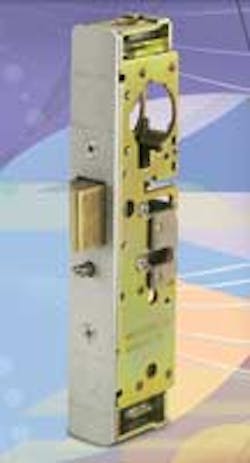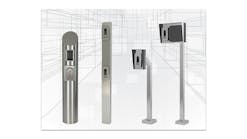When your customer calls you to put a 'buzzer' on a door, he or she usually means an electric strike. The ability to keep a door locked means added security. The ability to let specific people pass through that locked door means convenience. The combination of security and convenience can be achieved when an electric strike is installed on a door.
A lot of security products that will secure a door and control access. Electromagnetic locks, electrified locks and levers, electrified panic bars and stand-alone push-button locks are all available.
The simplicity of an electric strike is part of the reason that it's one of the most cost-effective means to secure an opening. In many cases, an electric strike can be installed with a plug-in power supply to achieve the combination of security and convenience the customer desires at considerable less cost than one of the alternative products mentioned above.
To properly suggest the right electric strike for your customer, a number of points need to be reviewed.
SURVEY
While many of the questions can be answered with a phone call, performing a simple site survey will ensure that your quote and recommendation will be accurate. Assuming and taking things for granted will usually come back to haunt you.
The short amount of time it takes to visit the job site and do a walk-through is worth it. Some security professionals charge for this service; some do not. Those that do charge for a bid survey usually credit that amount if the bid or quote is accepted.
One advantage of doing a walk-through is to get to know the customer and what his security needs actually are. The walk-through may provide an opportunity to assist the customer in obtaining the desired level of security.
APPLICATION
Lock types vary considerably. An electric strike is manufactured for almost any type of lock you can encounter. Cylindrical locks, tubular locks, mortise locks, panic bars and even deadbolts have compatible electric strikes. The variation of latch, bolt and dead latch dimensions and positions are compensated for by the design or adjustability of the electric strikes.
FRAME
Different electric strikes are available for wood and metal frames. By determining the type of frame, you can choose the proper strike. Aluminum frames, hollow metal frames, concrete-filled metal frames, snap-together light metal frames and wood frames all have different attributes that need to be considered.
A hollow metal frame will dissipate heat differently than a mortised wood frame. A concrete-filled frame might be the place you use a surface mounted strike instead of chipping, hammering and drilling out the required amount of concrete to accept the strike body, solenoid, and the wire run.
GRADE
The amount of usage or traffic the door will encounter is important information. A Grade 1 electric strike is intended for heavy-duty commercial use. Grade 2 is considered standard-duty commercial and/or heavy-duty residential and Grade 3 is light-duty. Using a Grade 2 or 3 electric strike in a Grade 1 application will save money in the short term but will probably result in a dissatisfied customer and a failed electric strike. Recommend the proper grade strike for the job.
STATUS
Electric strikes have a status denoting the state of the strike when it is at rest or without power applied. 'Fail-Safe' indicates that the lock is in an unlocked condition when no power is present. If the power fails, the door is unlocked.
In many jurisdictions this type of strike cannot be used in a stairwell or on a fire-rated exit. The reason is that when an electric strike is unlocked, the door can be pushed or pulled open without activating the lock or latch mechanism, so there is no positive latching. A fire door or stairwell must be kept latched to prevent fire and smoke from spreading to other parts of a building. In an emergency when power is lost, the doors must be kept latched.
'Fail-Secure' indicates that the lock is in a locked condition when no power is present. Again depending on the application, exit is accomplished at any time by activating the mechanical hardware. Turning the knob or lever or pushing the exit device withdraws the latch and provides egress.
NOTE: Always verify that you are meeting the state and local fire code life safety code requirements of a given electric strike installation by checking with the Local Authority Having Jurisdiction (LAHJ). In most instances the local fire marshal or fire inspector's office can put you in touch with the proper person.
DUTY
In the case of electric strikes there are two duties: intermittent or continuous. Intermittent duty electric strikes are energized only when power is supplied. The majority of the time they are at rest. An example of an intermittent duty electric strike is a Fail Secure electric strike. Only when power is provided will the electric strike unlock.
Continuous duty strikes have power applied continuously. Some fail-secure, continuous duty strikes are used when a door is kept unlocked during normal business hours. After hours, the power is removed and the strike can only be opened if power is supplied momentarily via a switch. In many installations a programmable timer is used to lock or unlock the strike at a pre-determined time or day.
Both fail-safe and fail-secure strikes are available in either intermittent or continuous duty status. Applying continuous power to an intermittent duty strike will most likely cause solenoid to burn out and the unit to fail.
FACE PLATES
The size and shape of the faceplate will determine how the strike body fits into the frame into which it is installed. By making a variety of different faceplates to fit the same case or body, the same lock can be used in a number of varying applications.
Also, the faceplate of the new strike can be matched to the dimensions of the old strike. So even if the lock body size of the new strike is smaller, the faceplate will fill the old opening eliminating the need for patching, filling or resizing the opening in the frame.
ADJUSTABILITY
Some manufacturers offer uniquely designed strikes that allow vertical, horizontal or lateral adjustment of the strike body or its components after installation. This lets you compensate for door or frame movement as a building settles or moves.
POWER & VOLTAGE
While most electric strikes utilize a simple plug-in transformer, some may require a heavier duty power supply. The voltage requirements for most electric strikes are 12 or 24 volts. Exceptions exist in the 16-18 volt range and some specialty applications may use a higher voltage. You need to know the rating of the power source when replacing an existing strike. If you install a 12 volt strike into a 24 volt power supply it will damage or destroy the strike and may actually cause a fire hazard.
If you install a 24 volt lock into a 12 volt power supply it will either not work properly or not work at all. It may unlock or lock intermittently but will not meet the customers' needs.
The other important piece of the puzzle is current. Alternating current (AC) and direct current (DC) are your two choices. AC strikes provide the familiar 'buzzing' noise that most customers are familiar with. DC strikes will provide a simple 'clunk' when the solenoid is engaged.
GAINING ACCESS
When an electric strike is installed, you need to determine how to release it when entry is desired. Some form of switch is required to break or complete the circuit to allow the strike to perform its intended function.
A simple push button located inside will let someone release the strike to allow access. Another option is installing a keypad or card reader to release the strike from the exterior. Of course using the mechanical key in the lock will allow entry but eliminates the strike from the action.
RECAP
When you are choosing an electric strike to meet your customer's needs, you need to consider whether to use fail-safe, fail-secure, 12 or 24 volts, AC or DC, intermittent or continuous duty etc.
Many electric strike manufacturers allow the locksmith to choose the voltage, current and status of the lock right in the field. By turning a screw, rotating and flipping a part or utilizing a jumper you can change the settings in seconds. The addition of multiple faceplates allows you to stock a minimum number of locks and parts on your service vehicle or in your shop to accomplish a multitude of strike applications.
Read the security industry trade magazines; attend the trade shows and training classes offered by the industry manufacturers and distributors to learn more about the wide variety of options you have to offer to your customer to solve their security needs.
Electric Strike Manufacturers
Electric strikes are available from the following manufacturers, as well as from your local locksmith distributor. The Electric Strike Product Spotlight includes information on some of the product choices.
Adams Rite Manufacturing Co., 260 Santa Fe St., Pomona, CA 91767. Telephone: 800-872-3267.
Web site: www.adamsrite.com.
Dynalock Corp., 705 Emmett St., Bristol, CT 06010. Telephone: 877-396-2562.
Web site: www.dynalock.com.
Folger Adam Electric Door Controls, 22630 N. 17th Ave., Phoenix, AZ 85027. Telephone: 800-626-7590. Web site: www.folgeradamedc.com.
H.E.S., 22630 N. 17th Ave., Phoenix, AZ 85027. Phone: 623-582-4626.
Web site: www.hesinnovations.com.
RCI, 210 Shearson Crescent, Cambridge, ON Canada N1T 1J6 or 2697 International Parkway / Parkway Five, Virginia Beach, VA 23452. Telephone: 800-265-6630 or 800-899-5625.
Web site: www.rutherfordcontrols.com.
Rofu International Corp., 7107 28th St. East, Tacoma, WA 98424 or 203-304 Main St. #403, Airdaie AB, Canada T4B 2T1.Telephone: 800-ALL-ROFU or 403-226-9830.
Web site: www.rofu.com.
Securitron Magnalock Corp., 550 Vista Blvd., Sparks, NV 89434. Telephone: 800-MAG-LOCK.
Web site: www.securitron.com.
Trine Access Technology, 1440 Ferris Pl., Bronx, NY 10461. Phone: 718-829-2332.
Web site: www.trineonline.com.
Von Duprin, 2720 Tobey Drive, Indianapolis, IN 46219. Telephone: 800-999-0408.
Web site: www.vonduprin.com.






